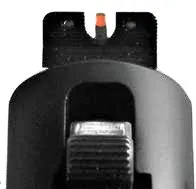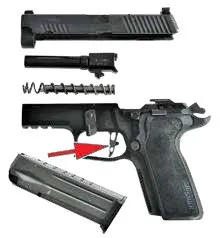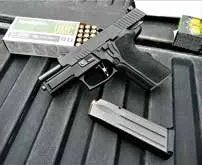The traditional double-action pistol, which generally begins with a long, heavy double-action initial pull then cycles to a lighter, better single-action trigger pull, remains popular. The long double-action trigger press is seen as a safety feature that doesn’t require extra manipulation of the controls. For example, the DA/SA pistol may safely be thrust into the waistband for to-the-mailbox carry or placed beside the bed for defense use. On the other hand, the DA-to-SA trigger action is like the stick shift of modern handguns — some don’t get it, and a legitimate criticism of the handguns is the sometimes difficult-to-manage double-action first-shot trigger.
That said, there have been improvements in the double-action trigger, and we recently tested three compact pistols that promoted some promise of an upgraded initial trigger pull. The trio are arguably among the best choices at a popular price point, around $1000, to just a little more. Our test guns were as follows:
Kriss Sphinx SDP Compact S4-WSDCM-E018 9mm Luger, $999;
Langdon Tactical Technology LTT Beretta 92 Elite LTT-92C-TJ-OP15 9mm Luger, $1184;
and the SIG Sauer P229 Elite-Compact E29R-9-BSE 9mm Luger, $1313.
Firing tests were conducted primarily with Remington UMC 9mm 115-grain FMJ ammunition. We also used a new brand to us Sierra 124-grain JHP, and added the Hornady American Gunner 124-grain XTP. We fired the FMJ loading for combat shooting and all three loads in the accuracy stage.
For the Beretta, CZ, or SIG fan looking for a carry gun to be all it can be, these three pistols should be at the top of the list. We rated the Kriss Sphinx and Langdon Beretta more improved than the SIG P229 Elite over their original factory-delivered templates, largely due to the superlative action job found on each worked-over pistol.
The Langdon Beretta, however, was easily the most elevated action job, over the original 92-Model pistol. A buyer looking for a superior carry gun will find good performance from any of these handguns.
Gun Tests Grade: A-
$1313
The P229 is a conventional double-action-first-shot pistol with an exposed hammer and hammer spur. The slide lock, magazine release, and decocker lever are located on the left side of the frame. The P229 operates smoothly with positive operation of all controls. This handgun is loaded by locking the slide to the rear, inserting a loaded magazine, and then lowering the slide using the slide stop. The decocker is pressed downward to lower the hammer to a safe position. The SIG features an internal firing pin block that prevents the firing pin from flying forward unless the trigger is pressed completely to the rear. While common today, SIG pioneered the firing-pin block for service pistols. This is also called a drop safety. In common with all double actions designed with a decock lever, never lower the hammer by pressing the trigger and controlling the hammer. This may result in short-circuiting the firing-pin block and rendering it useless or out of battery.
| Action Type | Semi-auto, double action to single action, locked breech |
| Overall Length | 7.1 in. |
| Height | 5.5 in. |
| Maximum Width | 1.6 in. |
| Weight Unloaded | 32.0 oz. |
| Weight Loaded | 38.4 oz. |
| Slide | Nitron-finished stainless steel |
| Slide Retraction Effort | 15.2 lbs. |
| Frame | Aluminum alloy, SIG rail |
| Front Strap Height | 2.3 in. |
| Rear Strap Height | 3.25 in. |
| Barrel | 3.9 in. long, carbon steel |
| Grip Thickness Max | 1.3 in., E2 type |
| Grip Circumference | 5.1 in. |
| Magazine | (2) 15 round |
| Rear Sight | SIGlite; drift adjustable, two tritium dots |
| Front Sight | SIGlite; replaceable post, single dot tritium |
| Sight Radius | 5.7 in. |
| Trigger-Pull Weight Double Action | 10.0 lbs. |
| Trigger-Pull Weight Single Action | 4.2 lbs. |
| Trigger Span Double Action | 2.75 in. |
| Trigger Span Single Action | 2.5 in. |
| Safety | No manual safety |
| Warranty | Lifetime to original owner |
| Telephone | (603) 610-3000 |
| Website | SIGarms.com |
| Made In | USA |
The double-action-first-shot pistol is fired with a long press of the trigger. The drawbar connecting the trigger to the hammer is internal. As the trigger is pressed, the hammer is brought to the rear. When the hammer breaks against the sear at the rearward most movement, the handgun fires. The slide recoils and then cocks the hammer for subsequent single-action shots. In single-action fire, you fire by a lighter press — the trigger action is shorter in this mode.

The SIG P229 Elite features a Nitron-finished stainless-steel slide. The frame is black-anodized aluminum. This is a modern handgun with a light rail for mounting combat lights. The slide features forward cocking serrations.
Take down is simple. Remove the magazine. Lock the slide to the rear, double check to be certain the pistol isn’t loaded, and rotate the take-down lever. The slide then runs forward when the slide lock is released. Press the guide rod and recoil spring out of the slide, and the barrel is easily lifted out. Maintenance is simple from that point.
The grip is the SIG E2 upgrade, which offers excellent tactile fit. The E2 is smaller than previous grips. While some shooters like the texture but cannot tell much difference, in trigger span for some, the E2’s smaller grip makes for just the right size and angle to master the P-series pistols. If you have a smaller hand or, like one of the raters, a large palm but short digits, this SIG upgrade is welcome. Another advantage of the Elite series is an elongated grip tang. The SIG, to the best of our knowledge, has never been a pistol with a hammer-bite problem. Just the same, this tang extension makes for more comfortable shooting and seems to lead the hand in a direct line to the target.

The pistol has two additional upgrades to the stock pistol pictured in the module on page 9. First, we ordered Trijicon night sights. Average price is $107, with some outlets asking much more. These sights boost the 24-hour capability of the pistol. These sights feature three white-dot inserts and a brilliant orange luminescent roundel surrounding the front sight, which is visible in all shooting conditions. We also added an Armory Craft flat trigger, $78. The flat trigger makes shooting the pistol quickly and accurately easier. There is even an adjustable trigger stop on this unit. We did no internal action work elsewhere. Added to the base price of the stock pistol ($1313), this rounds the SIG’s total price up to $1498 as tested.
The SIG P229 Elite is supplied with two 15-round magazines. Double-action trigger compression is 11.9 pounds on the Lyman digital scale. The single-action press is 4.2 pounds, exactly the weight at which most SIG pistols are set at the factory.
The SIG handled well in the loading and firing stages. The magazines are easy to load and positively locked in the frame. The double-action pull is long, but smooth, and gave centered hits at 7 yards. At 10 yards, we strayed often from the 10 ring, with hits in the 7, 8, and 9 rings when firing the double-action first shot. This is still excellent performance.
At 25 yards, the SIG rewarded us with the best groups of the test. With the American Gunner load, one five-shot group went into 1.5 inches, excellent results for a compact 9mm pistol. The SIG’s recoil is light, and the pistol’s reliability is faultless. Downside: The Sierra load’s velocity was disappointing. At 999 fps, this 124-grain JHP is well under the norm in performance. Compared to the other pistols, the SIG is most accurate.

Also, it is the only pistol with a hammer spur. This may be a minus in concealed carry, but on the other hand, the spur allows cocking the hammer for a single-action shot at long range.
The decocker is handy and rated above the Beretta but not the Sphinx, which is frame mounted as well but falls under the thumb easily. During the firing test, one of the raters suffered a failure of the slide to lock back on the last shot with every firing string. The rater was resting his thumb on the slide lock. This is addressed by training, but did not occur with the other handguns, so we can’t ignore it.
Also, we note an issue with the high Trijicon sights. They are a perfect sight for combat range, but they fire 3 inches high at 25 yards. It would be easy to have chosen a lower riding unit. This is simply the preference of the owner of the SIG and must be accounted for. By ignoring the top of the sight and using the tritium dots for aiming, we got back on target. Had they been factory products, we would have rated them down a half grade.
Our Team Said: We did rate the pistol down a half grade on the common slide lock problem, which isn’t quite a design defect because only some hand sizes are affected.
Range Data
All groups were fired at 15 yards from a braced benchrest position using an MTM K Zone pistol rest. We used a Competition Electronics Pro Chrony to measure velocity. The first chronograph screen was 10 feet from the muzzles of the firearms.
| Remington UMC 115-grain FMJ L9MM3BC | SIG P229 Elite | Langdon Beretta | Kriss Sphinx |
| Average Velocity | 1110 fps | 1120 fps | 1124 fps |
| Muzzle Energy | 315 ft.-lbs. | 320 ft.-lbs. | 323 ft.-lbs. |
| Small Group | 1.5 in. | 1.7 in. | 1.8 in. |
| Average Group | 1.8 in. | 2.0 in. | 2.2 in. |
| Hornady American Gunner 124-grain XTP +P 90224 | SIG P229 Elite | Langdon Beretta | Kriss Sphinx |
| Average Velocity | 1180 fps | 1166 fps | 1174 fps |
| Muzzle Energy | 383 ft.-lbs. | 374 ft.-lbs. | 379 ft.-lbs. |
| Small Group | 1.7 in. | 2.0 in. | 1.9 in. |
| Average Group | 2.0 in. | 2.4 in. | 2.4 in. |
| Sierra Outdoor Master 124-grain JHP A8124 | SIG P229 Elite | Langdon Beretta | Kriss Sphinx |
| Average Velocity | 999 fps | 1023 fps | 1011 fps |
| Muzzle Energy | 275 ft.-lbs. | 288 ft.-lbs. | 281 ft.-lbs. |
| Small Group | 2.3 in. | 2.5 in. | 2.7 in. |
| Average Group | 2.7 in. | 3.0 in. | 3.4 in. |






























You said “The rater was resting his thumb on the slide lock. This is addressed by training, but did not occur with the other handguns, so we can’t ignore it.”
I have a P229 Ellite. If your rater was resting his thumb on the slide lock, he doesn’t know how to grip the pistol. You should have downgraded the rater, not the P229.